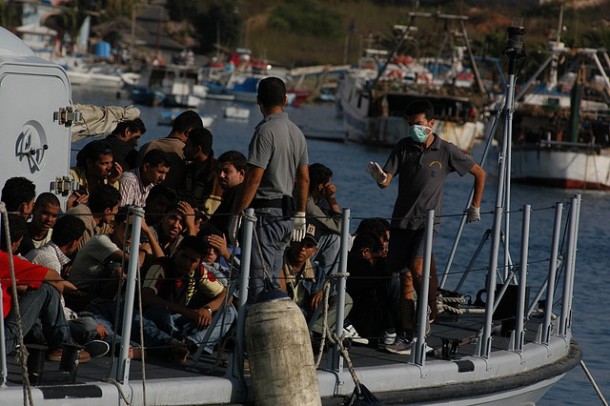Irregular migration to Europe has been sharply increasing since 2008. According to the EU Border Agency Frontex, 51 per cent of migrants entering the EU illegally until 2012 did so via Greece, yet by the following year the trend had changed. Since 2013, it has been the central Mediterranean passage from Libya to Italy to bear the largest burden of irregular migration.
The “Italian route” has been the fastest way for thousands of Tunisians fleeing their country after the outbreak of the Arab Spring in 2011, who have been soon followed by many Sub-Saharan Africans leaving post-Qaddafi Libya – a country which instead attracted people until few years ago, before the government’s collapse in a civil war.
According to Frontex’s data, migration flows from Africa to Italy have increased by 288% in 2014 – an impressive amount, compared to the slight percentage changes affecting the Western Mediterranean Route to Spain (+7%) and the Eastern Mediterranean Route to Greece and Bulgaria (-33%).
This has occurred, however, at a time of great strain for many EU Member States.
It could be easily understood that a long-lasting economic crisis and impressively low growth rates are likely to negatively affect popular attitudes to humanitarian concerns and migratory issues. You could easily imagine people in Italy wondering how far the government should sustain the costs of a migrant assistance program when its support for Italian citizens is already poor. But how much does migrant assistance really cost to Italy? How much is provided to migrants?
The Italian System of Protection for Asylum Seekers and Refugees (SPRAR), established in 2002, consists of a network of local authorities running reception projects for people forced to migrate. It is financed through the National Fund for Asylum policies and services. The budget for the SPRAR has been constantly increasing since 2009; in 2014 has been around € 180 million, divided between over 400 local reception structures which receive around € 40-45 for assisted person.
SPRAR facilities, however, are not sufficient for everyone; temporary structures, including Cara, Cpa and Cpsa, have been created meanwhile. They are financed through national and EU funds and receive private donations as well. Money is allocated on each facility on a basis similar to SPRAR.
The total EU funding to Italy for the period 2014-2020 approved early this month by the European Commission is approximately € 558 million: it is provided under the AMIF (EU Asylum, Migration and Integration Fund) and the Internal Security Fund (ISF) and it is the largest quota to be granted to a single EU State Member (Spain and Greece came second and third with with € 522 and € 474 million respectively).
Pocket money to migrants, as settled by Italian authorities, is fixed at € 2,50 pro capite and pro die: each migrant receive it on a daily basis and spend it mainly inside a facility. The remainder of the quota is destined to the centre covering the job of many people working in it providing food, accommodation and assistance to migrants.
Suggested readings
EU Commission, “Managing migration and financing a safer and more secure Europe: € 2.4 billion to support Member States”, 10 August 2015. (English)
Frontex, “Annual Risk Analysis, 2014”, May 2015. (English)
SPRAR (Sistema di Protezione per Richiedenti Asilo e Rifugiati), “Rapporto Annuale SPRAR”, Aprile 2015. (Italian)
Internazionale, “Quanto costa l’accoglienza ai migranti?”, 9 giugno 2015. (Italian)

